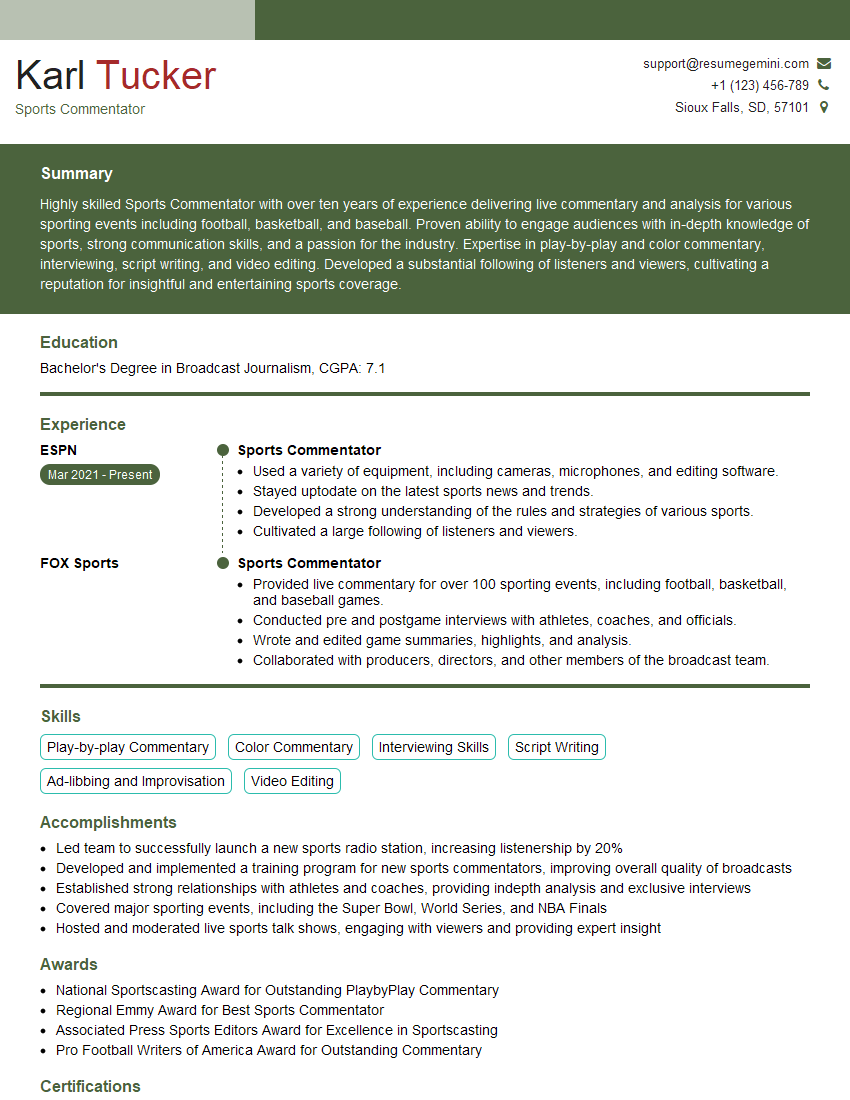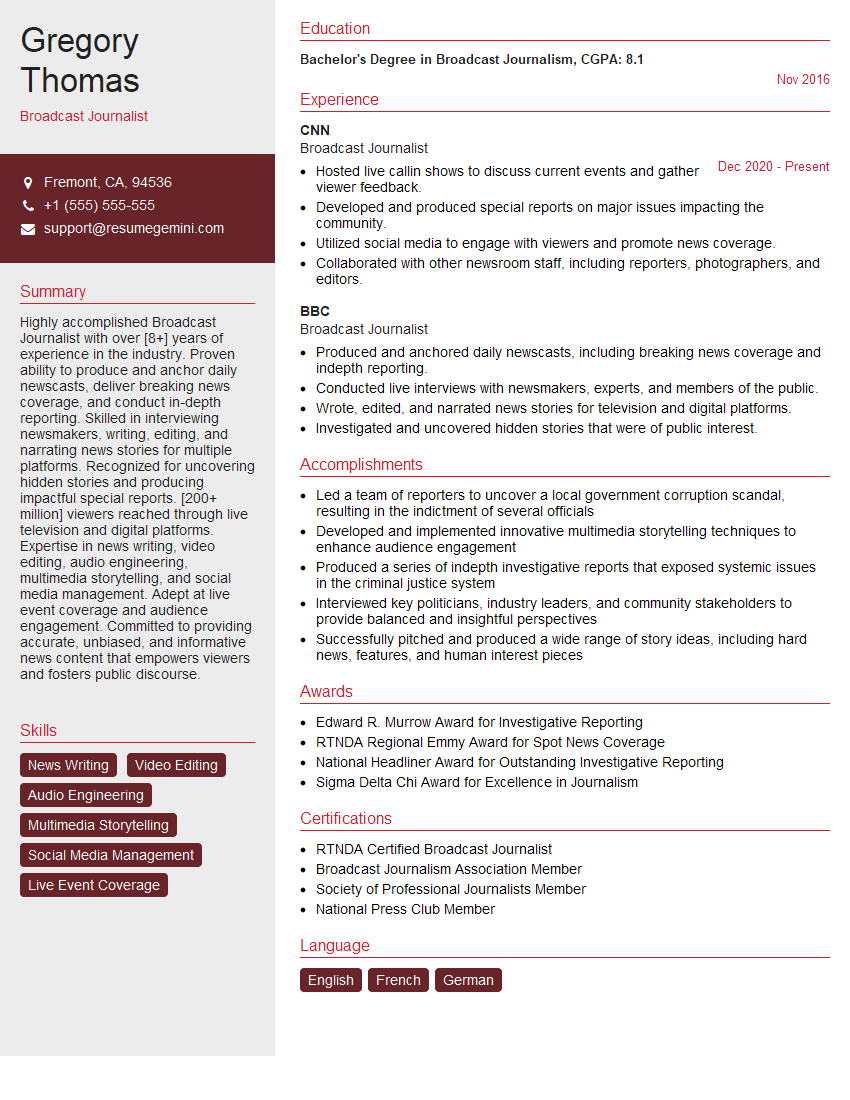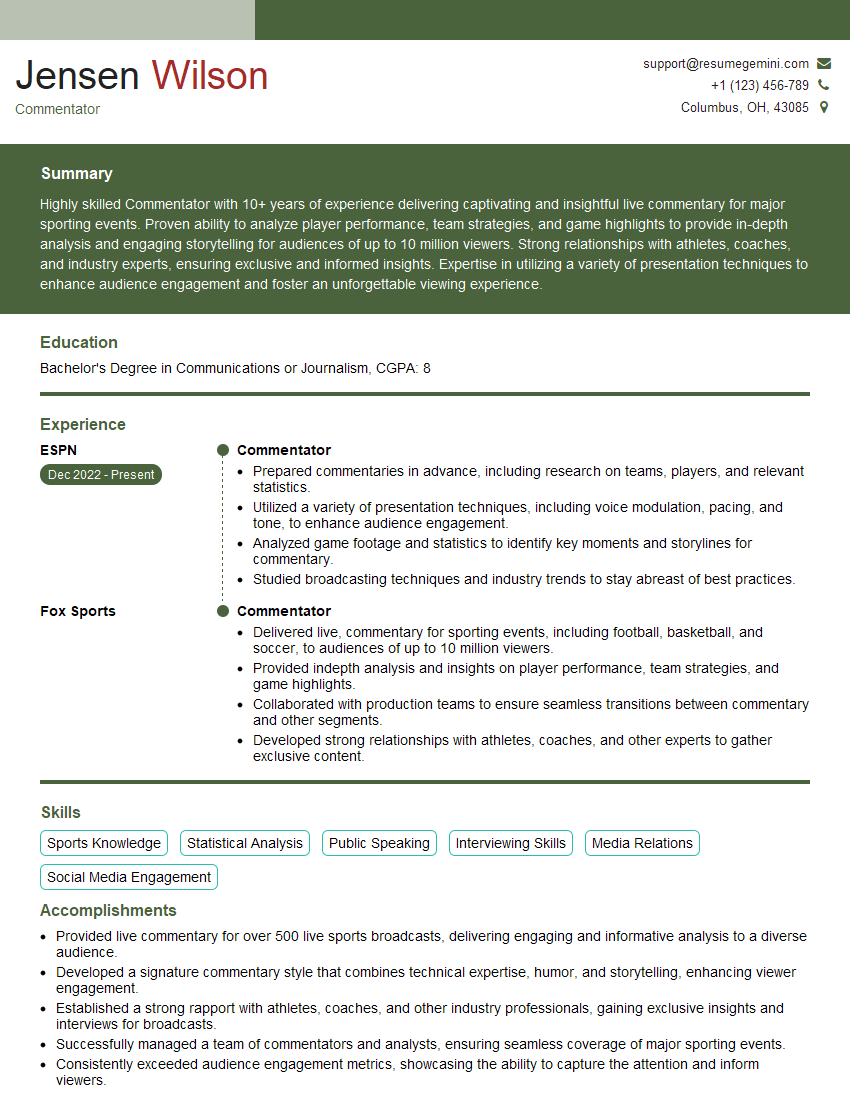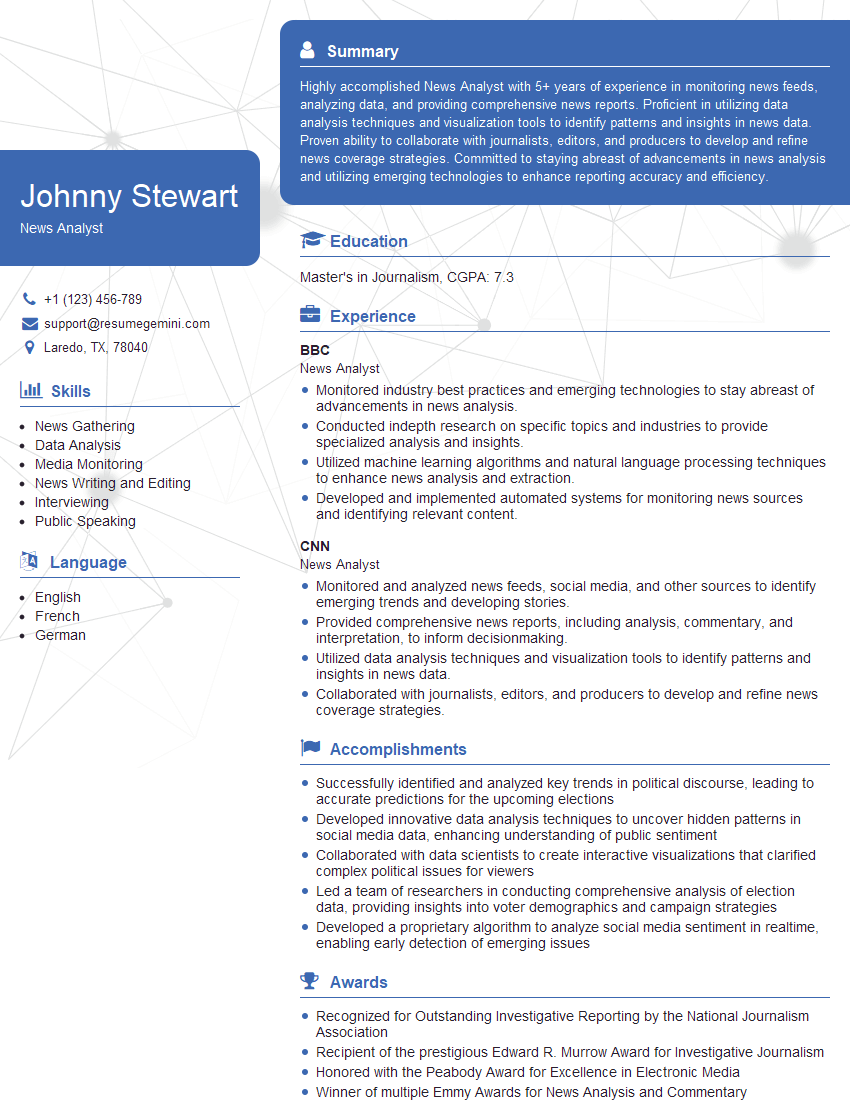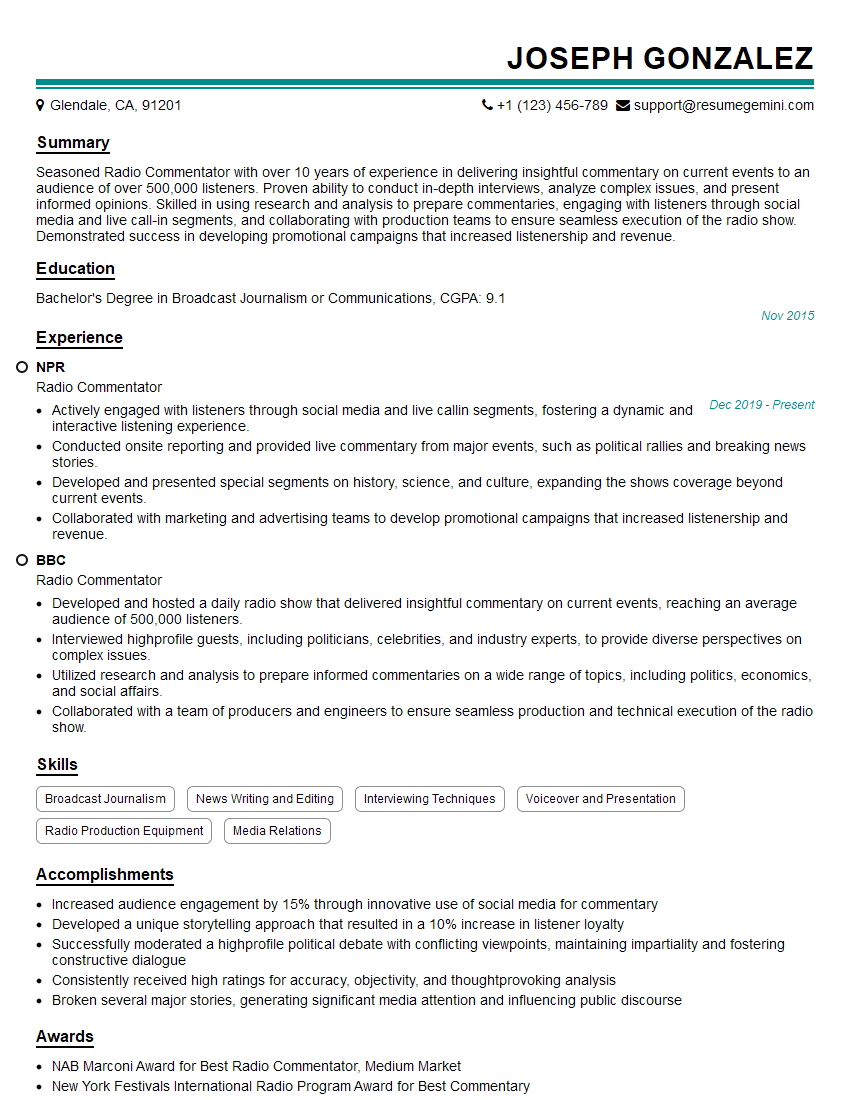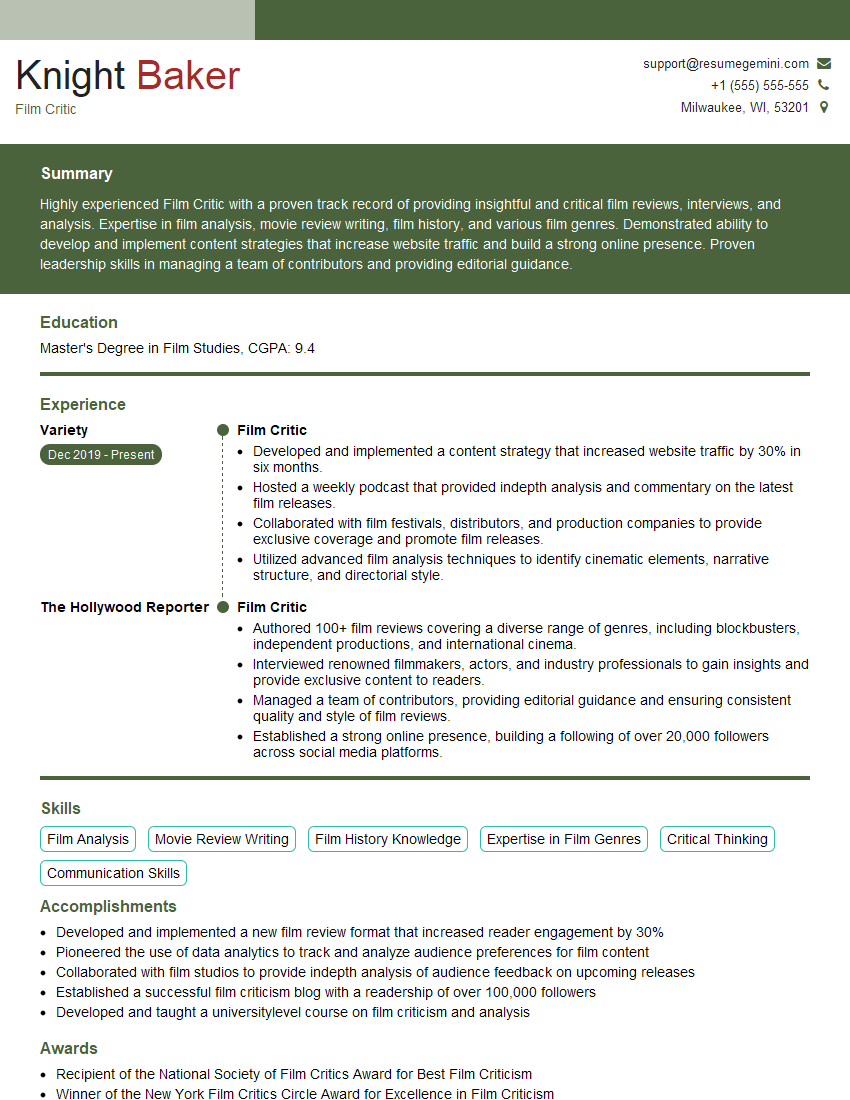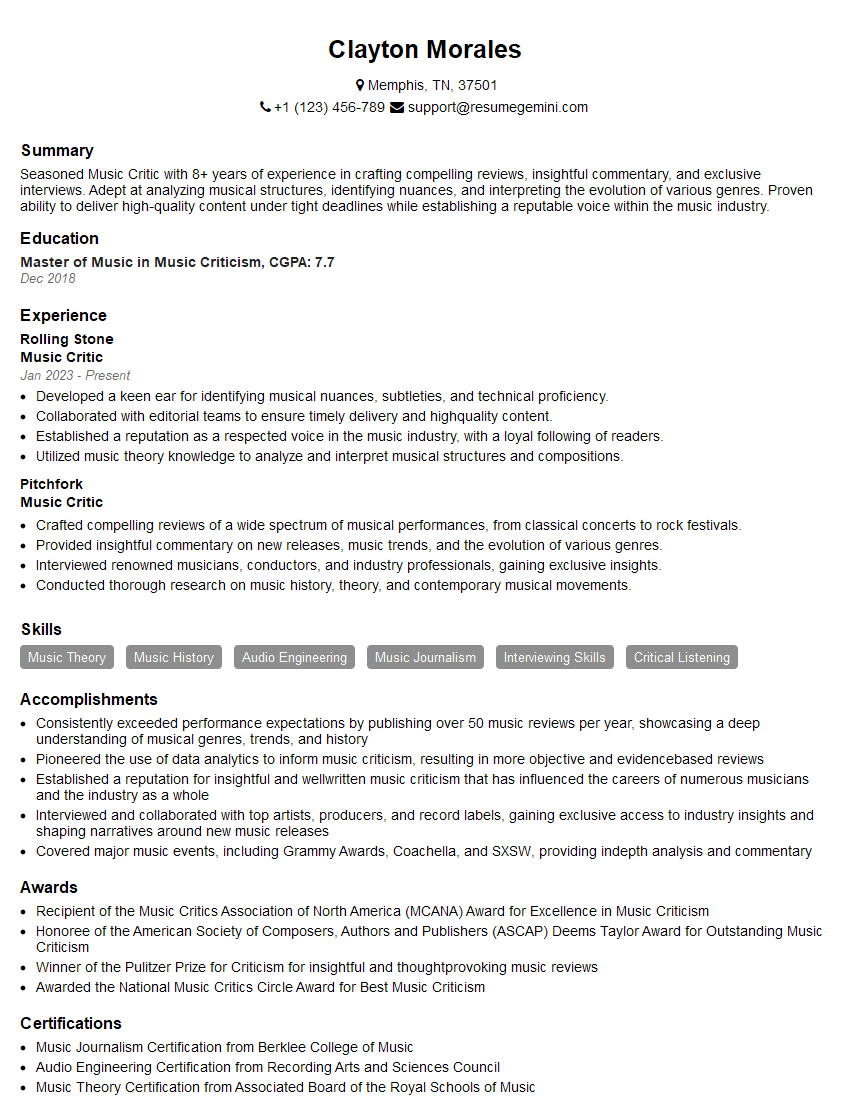Feeling uncertain about what to expect in your upcoming interview? We’ve got you covered! This blog highlights the most important Commentary interview questions and provides actionable advice to help you stand out as the ideal candidate. Let’s pave the way for your success.
Questions Asked in Commentary Interview
Q 1. Explain your understanding of the role of a commentator.
The role of a commentator is multifaceted. At its core, a commentator acts as a bridge between the event and the audience. They provide context, analysis, and narrative, enhancing the viewer or listener’s understanding and enjoyment of the event. This involves not only describing what’s happening in real-time but also providing insightful interpretation, background information, and engaging storytelling to keep the audience captivated. Think of it as being a real-time storyteller, weaving a compelling narrative around the unfolding action. A good commentator needs to be knowledgeable about the subject matter, possess excellent communication skills, be quick-witted, and able to adapt to unexpected circumstances.
Q 2. Describe your experience providing commentary in different mediums (e.g., radio, TV, online).
My experience spans various mediums. I’ve provided live commentary for radio broadcasts of local sporting events, where the focus is on concise, clear delivery and maintaining a fast pace to keep listeners informed. This demanded a very descriptive style to paint a picture for the listener. My television commentary experience has involved a more visual style, incorporating analysis through on-screen graphics and interacting with co-commentators. Finally, my online commentary work, primarily on live-streaming platforms, has involved a more interactive approach, engaging directly with viewers through a chat function and adapting my commentary based on their real-time feedback. Each medium presents unique challenges and requires a tailored approach to effectively connect with the audience.
Q 3. How do you prepare for a live commentary event?
Preparation for a live commentary event is crucial. It starts with thorough research: I delve deeply into the background of the event, the participants involved, their past performances, key statistics, and any relevant news or controversies. For instance, if I’m commentating on a football match, I’ll study team lineups, recent form, player profiles, and even analyze historical head-to-head records. This research forms the foundation of my understanding. Then, I’ll create an outline or talking points to guide the commentary, ensuring I cover key aspects while still allowing room for spontaneity. I also rehearse my delivery and ensure I’m comfortable with the equipment and technology being used. Finally, I review any pre-game interviews or press conferences to gain extra insight. This thorough preparation minimizes surprises and maximizes my effectiveness during the live event.
Q 4. How do you maintain objectivity while providing commentary?
Maintaining objectivity is paramount. While passion and enthusiasm are desirable, it’s vital to avoid bias or favoritism. I achieve this by focusing on factual reporting and presenting a balanced perspective. I strive to present the events impartially, highlighting both successes and failures of all parties involved without personal opinion. This requires careful word choice and conscious awareness of my own potential biases. For example, if commentating on a sporting event, I’ll focus on the performance data, the strategic decisions made by teams, and the objective outcomes rather than expressing personal preferences for a particular team or player. I make sure that my commentary reflects the actual events and avoids any interpretation that is subjective or opinion-based.
Q 5. How do you handle unexpected events or changes during a commentary session?
Unexpected events are inevitable in live commentary. My approach is to remain calm, adaptable, and resourceful. I utilize my pre-event research to provide context, even if the unforeseen event deviates from the expected script. For instance, if a key player is unexpectedly injured, I draw upon my background knowledge to provide insight on their role in the team, potential replacements, and the overall strategic implications of the injury. This requires a significant amount of improvisation and the ability to think on your feet. The key is to react quickly, maintain a professional demeanor, and fill any gaps in the narrative seamlessly. This is where experience and thorough research become essential.
Q 6. Explain your process for conducting research before a commentary assignment.
My research process is systematic. It always begins with identifying key players, teams, or topics. Then, I research their history and recent performance. I use a variety of sources including official websites, news articles, statistical databases, and expert opinions. For example, if I’m commentating on a political debate, I’d study the candidates’ political platforms, past statements, voting records, and analyze news coverage about them. I actively look for patterns, trends, and inconsistencies in the information gathered. I use this data to create a comprehensive understanding of the subject matter, which helps me contextualize the events, anticipate potential outcomes, and provide informed commentary. I always aim to cross-reference information from multiple sources to ensure accuracy and identify potential biases.
Q 7. How do you adapt your commentary style to different audiences?
Adapting commentary style to different audiences is crucial for effective communication. For a younger audience, I might use a more informal and engaging tone, incorporating relatable analogies and humor. For a more academic audience, I’d employ a more formal and detailed style, incorporating technical jargon and in-depth analysis. For a general audience, I’ll strike a balance between simplicity and depth, making sure to explain complex topics in an easy-to-understand way. This necessitates understanding the demographic, their level of prior knowledge and the purpose of the event. I try to find the appropriate balance to ensure clarity and maintain audience engagement without losing the credibility of the message. For example, when commentating on a scientific discovery for a public audience, I’d avoid overly technical terms and instead focus on its implications and impact. However, while commentating for a group of scientists, I’d feel comfortable using more technical terminology.
Q 8. Describe a time you had to deliver commentary under pressure.
One of the most pressure-filled commentary experiences I had was during the final match of a national championship. The game went down to the wire, with the score tied in the final seconds. The tension was palpable, not just for the players, but for everyone involved, including myself. The pressure stemmed from the high stakes – millions were watching, and every word I uttered carried significant weight. I had to maintain composure, analyze the rapidly changing situation accurately, and deliver concise, engaging commentary without revealing my own biases or anxieties. To manage this, I focused on my breathing, reminded myself of my preparation, and concentrated on accurately describing the action, rather than focusing on the outcome. I employed a technique I call ‘controlled observation,’ where I focus on describing what’s happening in detail (player movement, ball trajectory, etc.), thereby pushing aside the pressure of the game’s importance. The resulting commentary was praised for its clarity and objectivity, even under immense pressure.
Q 9. How do you handle criticism of your commentary?
Criticism is an inevitable part of commentary. I approach it constructively, viewing it as an opportunity for growth. First, I analyze the criticism itself. Is it constructive, pointing towards areas I can improve? Or is it purely subjective and based on personal preference? For constructive criticism, I identify specific patterns or areas to focus on. For instance, if feedback consistently mentions a lack of clarity in my explanations of complex strategies, I will spend time practicing concise explanations of those strategies, perhaps with the help of visual aids beforehand. If the criticism is subjective, I acknowledge it but don’t necessarily let it influence my approach drastically, as long as it’s not against ethical guidelines. I’ve found that maintaining a professional demeanor, listening attentively to feedback (even negative feedback), and consistently striving to improve my skills are crucial in handling criticism professionally.
Q 10. How do you engage with your audience during a commentary session?
Engaging the audience is paramount in commentary. I aim to create a conversational tone, making the viewers feel like they’re part of the event, not just passive observers. This involves using inclusive language, anticipating their questions, and explaining technical aspects in a relatable way. For instance, instead of simply saying ‘The winger executed a deft maneuver,’ I might say, ‘Watch how quickly the winger cuts inside, using his body to shield the ball and create space – a truly skillful move!’ I also incorporate anecdotes and background information relevant to the event or athletes, to add depth and interest. I try to keep a balance between detailed technical analysis and entertaining storytelling, keeping the pace lively and preventing the commentary from feeling monotonous. I also encourage interaction through social media during broadcasts where feasible. The goal is to connect with viewers on an emotional and intellectual level.
Q 11. Explain your understanding of different commentary styles and approaches.
Commentary styles are diverse. You have the play-by-play style, focusing on describing the action as it unfolds, moment by moment. This requires speed, accuracy, and a clear concise style. Then there’s the color commentary style, which provides context, analysis, and background information, adding depth and insight. A more analytical approach might delve into tactical strategies, player statistics, and historical context. Finally, a more narrative approach frames the game within a broader story, focusing on the human drama and emotion. My style tends to be a blend of play-by-play and color commentary, leaning towards the analytical when appropriate. I adapt my approach based on the event, audience, and co-commentators, striving for a balance between factual accuracy and engaging storytelling. For example, during a high-school football game, a simpler play-by-play style might be more suitable, whereas a professional game may require more in-depth analysis.
Q 12. How do you ensure accuracy and factual correctness in your commentary?
Accuracy is non-negotiable in commentary. I meticulously research before any event, ensuring I’m familiar with the players, teams, and relevant statistics. I verify information from multiple reliable sources, cross-referencing data to avoid inaccuracies. During live events, I have access to real-time information through scoreboards, statisticians, and colleagues. However, I also employ a self-checking mechanism, constantly reviewing what I’m saying to ensure accuracy and consistency. When unsure about a detail, I refrain from making speculative statements and admit if I don’t know the answer, maintaining transparency with the audience. This approach builds trust and credibility. If I make a mistake, I promptly correct it, acknowledging the error and apologizing if needed, which is crucial for maintaining integrity.
Q 13. Describe your experience working with other commentators or journalists.
Collaborating with other commentators and journalists has been invaluable. Effective teamwork is based on mutual respect, clear communication, and a shared goal. I’ve learned to adapt my style to complement the strengths of my colleagues, sometimes taking a more leading role and at other times supporting their expertise. For example, if a co-commentator possesses deep tactical knowledge, I might focus on narrative aspects, thereby creating a balanced and engaging commentary team. Constructive feedback is essential; I actively seek and offer suggestions, creating a dynamic and supportive working environment. This helps in creating seamless transitions between different commentary styles and ensuring consistency in presentation. Strong communication beforehand ensures we know each other’s strengths and preferences, leading to better collaboration.
Q 14. How do you manage your time effectively while providing live commentary?
Effective time management during live commentary is crucial. Preparation is key. I carefully plan the structure of my commentary, outlining key points and anticipating potential scenarios. I utilize concise language and clear structure, avoiding overly long or convoluted sentences. I also practice delivering commentary under timed conditions, to refine my speed and efficiency. During the event itself, I focus intently on the action, prioritizing accurate and timely information over unnecessary details. I trust my preparation and knowledge, which allows me to focus on the current moment and adjust my commentary accordingly. A good team of researchers and producers also play a vital role, ensuring I have access to the right information at the right time. Good time management is about striking a balance between detailed analysis and maintaining a good pace to keep the audience engaged.
Q 15. How do you incorporate statistical data into your commentary?
Incorporating statistical data into commentary is crucial for providing context and supporting claims. It adds weight and objectivity to my analysis, moving beyond mere opinion. I use statistics to illustrate trends, compare performances, and highlight significant events. For instance, in a sports commentary, I might cite batting averages to support a claim about a player’s current form or use win percentages to illustrate a team’s dominance. The key is presenting the data clearly and concisely, avoiding jargon and explaining its significance to the audience. I often use visual aids like graphs or charts (if available during the broadcast) to present data effectively. For example, ‘As you can see on this graph, team A’s goal-scoring rate has increased dramatically over the last five games.’ This way, statistical information is not just presented, but is seamlessly integrated into the narrative, enhancing the understanding and engagement of the audience.
Career Expert Tips:
- Ace those interviews! Prepare effectively by reviewing the Top 50 Most Common Interview Questions on ResumeGemini.
- Navigate your job search with confidence! Explore a wide range of Career Tips on ResumeGemini. Learn about common challenges and recommendations to overcome them.
- Craft the perfect resume! Master the Art of Resume Writing with ResumeGemini’s guide. Showcase your unique qualifications and achievements effectively.
- Don’t miss out on holiday savings! Build your dream resume with ResumeGemini’s ATS optimized templates.
Q 16. How do you stay up-to-date with relevant news and information?
Staying updated is paramount in commentary. My approach is multifaceted. Firstly, I subscribe to reputable news agencies and sports publications relevant to my area of expertise. Secondly, I follow key figures and organizations on social media for immediate updates and breaking news. Thirdly, I attend press conferences and briefings when possible, which provides invaluable firsthand information and allows me to ask direct questions to involved parties. Finally, I maintain a network of contacts within the field – journalists, analysts, and other commentators – who can provide insights and perspectives.
- News Agencies: Reuters, Associated Press, etc.
- Sports Publications: ESPN, specific sports magazines related to the sport being covered.
- Social Media: Twitter, professional sports teams’ websites, and athletes’ official accounts.
This combined approach ensures I am equipped with a comprehensive view and can react quickly to changes and developing stories.
Q 17. How do you handle technical difficulties during a live commentary session?
Technical difficulties during live commentary are unavoidable. My approach is based on preparedness and quick thinking. I always have a backup plan, including alternative equipment and communication channels. If the primary audio feed fails, I’m ready to switch to a phone line or backup microphone. If visuals are lost, I adapt my commentary to focus more on the audio narrative, providing rich descriptions and detail. Crucially, I maintain calm and professional demeanor. Panicking will only exacerbate the problem. I communicate calmly and clearly with the technical team while continuing to provide commentary as smoothly as possible. In my experience, viewers appreciate transparency; a simple, ‘We’re experiencing a slight technical issue, but we’ll be back shortly,’ is reassuring. The key is to minimize disruption and maintain the flow of information for the listeners or viewers.
Q 18. Describe your experience using different commentary tools or software.
My experience encompasses a range of commentary tools. I’m proficient with audio mixing consoles, allowing me to control sound levels and manage multiple inputs. I am familiar with various broadcast software packages, including those for play-by-play updates, scorekeeping, and graphics integration. I’ve used sophisticated audio editing software for post-production work, ensuring consistency and professionalism. I’m also adept at using teleprompters, enabling me to seamlessly integrate prepared statements and statistics while still sounding natural and engaging. For remote commentaries, I’m comfortable with video conferencing platforms and specialized remote broadcasting systems ensuring connectivity and audio/video quality. Each tool has its own strengths, and knowing how to utilize them effectively is a crucial aspect of successful commentary.
Q 19. How do you identify and prioritize key points during a commentary assignment?
Identifying and prioritizing key points involves a combination of preparation and intuition. Before a commentary assignment, I thoroughly research the subject, identifying potential key events or talking points. This might involve reviewing statistics, understanding historical context, and assessing the current situation. During the event itself, I constantly evaluate what’s happening, focusing on significance and impact. For instance, a late goal in a football match will naturally supersede a minor foul earlier in the game. I utilize a mental framework, prioritizing information based on its relevance to the narrative, its newsworthiness, and its interest to the audience. Using a mental checklist helps organize my thoughts and ensures I do not miss important details. This dynamic approach allows me to adapt to unforeseen events and provide insightful and relevant commentary.
Q 20. How do you maintain a consistent tone and style in your commentary?
Maintaining a consistent tone and style requires self-awareness and planning. I define my target audience and tailor my language and delivery accordingly. For example, commentary for a family-friendly broadcast will differ significantly from a commentary intended for a specialized sports channel. I develop a ‘voice’ that remains professional yet engaging, using vivid descriptions and concise language. Consistency is about avoiding abrupt shifts in tone or style. Regular review of previous work helps to identify and correct any inconsistencies in my approach. Paying attention to my pacing, intonation, and vocabulary ensures my commentary maintains a professional and engaging quality.
Q 21. How do you balance factual reporting with your own opinion or analysis?
Balancing factual reporting with opinion requires a delicate touch. I firmly believe in presenting accurate information as a foundation. My analysis and opinions are built upon this foundation, clearly separating my interpretation from objective facts. I utilize phrases like, ‘In my opinion…’ or ‘I believe that…’ to clearly distinguish personal views from established facts. I avoid sensationalism and unfounded speculation. Instead, I aim to offer insightful analysis that enriches the audience’s understanding, rather than imposing my views. Transparency and clarity are paramount. By clearly separating facts from interpretations, I build credibility and foster trust with my audience.
Q 22. Explain your approach to providing insightful and engaging commentary.
Insightful and engaging commentary hinges on a blend of thorough preparation, clear communication, and a genuine connection with the audience. My approach begins with deep research into the subject matter. This ensures I possess a comprehensive understanding, enabling me to offer nuanced perspectives and avoid superficial observations. I then craft a narrative structure, anticipating key moments and potential developments. This proactive strategy allows for a dynamic and responsive commentary, even when events unfold unexpectedly. Finally, I prioritize clear and concise language, avoiding jargon unless absolutely necessary, and injecting my personality to foster a relatable connection with the listener or viewer. For example, during a sports commentary, I wouldn’t simply state the score; I’d weave it into a story highlighting the players’ strategies, their emotional states, and the overall flow of the game.
Q 23. How do you use storytelling techniques to make your commentary more appealing?
Storytelling is the backbone of compelling commentary. Instead of simply relaying facts, I construct a narrative arc. This involves identifying a beginning, middle, and end, even within a short segment of commentary. Consider a political debate: I wouldn’t just list the candidates’ policy positions. Instead, I’d present them as characters within a larger story of ideological conflict, highlighting their motivations, the historical context of their arguments, and the potential consequences of their proposed actions. I use vivid imagery and evocative language to paint pictures in the listener’s mind. For instance, instead of saying ‘The market fluctuated,’ I might describe it as ‘a rollercoaster ride of gains and losses, leaving investors breathless.’ The use of metaphors and analogies makes complex information more accessible and memorable.
Q 24. Describe your experience with different types of commentary assignments (e.g., sports, news, political).
My experience spans diverse commentary formats. In sports, I’ve covered everything from high-school basketball to professional soccer, learning to adapt my style to the specific demands of each sport and audience. For example, basketball commentary requires a rapid-fire delivery and a keen eye for individual player performance, while soccer often demands a more strategic and analytical approach. In news commentary, I’ve analyzed breaking events, providing context and interpretation for viewers. This necessitates a more formal tone and a focus on accuracy and objectivity. Political commentary, on the other hand, calls for a deft balance between insightful analysis and respectful discussion of potentially controversial viewpoints. I’ve learned to navigate the complexities of each genre by carefully tailoring my language, tone, and analytical framework to the specific context.
Q 25. How do you handle interruptions or questions during a commentary session?
Handling interruptions and questions smoothly is crucial for maintaining the flow of commentary. My strategy involves acknowledging the interruption with a brief, courteous response, such as ‘That’s an excellent question,’ before seamlessly integrating the question or comment into my existing narrative. If the interruption is irrelevant, I might politely defer it until a more appropriate moment. For example, if during a live sports commentary, a technical issue interrupts the broadcast, I would calmly explain the situation to viewers while keeping the commentary engaging by focusing on an exciting element of the game. The key is to remain calm, professional, and maintain control over the narrative while adapting to unforeseen circumstances.
Q 26. How do you deal with controversial topics or sensitive information during commentary?
Navigating controversial topics and sensitive information requires a nuanced approach. My guiding principles are accuracy, fairness, and respect. I strive to present all sides of an issue objectively, avoiding biased language or inflammatory rhetoric. I prioritize factual accuracy and cite credible sources to support my claims. When dealing with sensitive information, I use careful and considerate language, acknowledging the potential impact of my words on different audiences. For example, when discussing a politically divisive topic, I would preface my commentary by stating the multiple perspectives involved and strive to present evidence-based arguments rather than relying on opinion alone. The goal is to foster understanding rather than to fuel conflict.
Q 27. How do you adapt your commentary to suit a particular platform or audience?
Adapting to different platforms and audiences is essential for effective commentary. The language, style, and tone of commentary should be tailored to the specific context. For example, a commentary for a younger audience might employ a more informal style and incorporate humor, while commentary for an academic audience would demand a higher level of formality and a focus on analytical depth. The medium also influences style: A radio commentary requires vivid descriptions to compensate for the lack of visuals, while a television commentary can leverage visual cues. Understanding the platform’s limitations and the audience’s expectations is crucial for delivering impactful commentary.
Q 28. What are your strengths and weaknesses as a commentator?
My strengths lie in my ability to synthesize complex information into clear and engaging narratives, my adaptability to different formats and audiences, and my capacity for remaining calm and professional under pressure. However, a weakness can be my tendency towards perfectionism, which sometimes leads to over-preparation. I am working on balancing thorough preparation with the ability to be flexible and spontaneous. I also actively solicit feedback to improve my ability to connect with different audiences and adapt my style accordingly.
Key Topics to Learn for Commentary Interview
- Understanding Narrative Structure: Analyze different narrative structures and their effectiveness in conveying a message. Consider how to build compelling narratives within a commentary context.
- Mastering Concise and Engaging Language: Practice writing clearly, accurately, and engagingly within word count constraints. Explore techniques for impactful word choice and sentence construction.
- Analyzing Source Material Critically: Develop skills in dissecting complex information and forming informed, nuanced opinions. Practice identifying biases and strengths in various sources.
- Developing a Unique Perspective: Learn to articulate original insights and analyses, showcasing your ability to go beyond simple summarization. Explore methods for adding your unique voice to commentary.
- Effective Argumentation and Support: Master techniques for building strong, persuasive arguments supported by evidence and logical reasoning. Practice structuring arguments effectively.
- Adapting to Different Audiences: Understand how to tailor your commentary to specific audiences and their expectations. Consider the impact of tone, style, and language choice on different readerships.
- Fact-Checking and Verification: Develop rigorous fact-checking skills to ensure accuracy and credibility in your work. Understand the ethical implications of misinformation.
- Responding to Counterarguments: Practice anticipating and addressing potential counterarguments to your viewpoints. Develop strategies for maintaining a balanced and objective presentation.
Next Steps
Mastering the art of commentary opens doors to exciting career opportunities in journalism, media, and analysis. A strong understanding of these key concepts will significantly improve your interview performance and career prospects. To further enhance your job search, focus on creating an ATS-friendly resume that highlights your skills and experience effectively. Use ResumeGemini to build a professional resume that stands out; they provide examples tailored to Commentary roles to help you get started. Investing in your resume is an investment in your future success.
Explore more articles
Users Rating of Our Blogs
Share Your Experience
We value your feedback! Please rate our content and share your thoughts (optional).
What Readers Say About Our Blog
Dear Sir/Madam,
Do you want to become a vendor/supplier/service provider of Delta Air Lines, Inc.? We are looking for a reliable, innovative and fair partner for 2025/2026 series tender projects, tasks and contracts. Kindly indicate your interest by requesting a pre-qualification questionnaire. With this information, we will analyze whether you meet the minimum requirements to collaborate with us.
Best regards,
Carey Richardson
V.P. – Corporate Audit and Enterprise Risk Management
Delta Air Lines Inc
Group Procurement & Contracts Center
1030 Delta Boulevard,
Atlanta, GA 30354-1989
United States
+1(470) 982-2456
